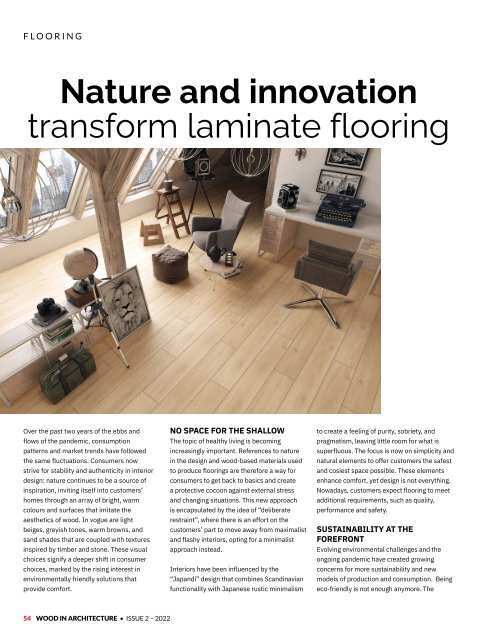Wood In Architecture Issue 2, 2022
First published in 2017, Wood in Architecture (WIA) is a bi-annual trade magazine devoted to the international timber construction sector. The newest addition to the Panels & Furniture Group of wood magazines, WIA features in-depth insights to the latest industry news, incredible projects and leading trade events. WIA is an advocate for timber as a material of choice for today’s built environment, and is the perfect source of inspiration for architects, builders, engineers and interior designers across the globe.
First published in 2017, Wood in Architecture (WIA) is a bi-annual trade magazine devoted to the international timber construction sector. The newest addition to the Panels & Furniture Group of wood magazines, WIA features in-depth insights to the latest industry news, incredible projects and leading trade events. WIA is an advocate for timber as a material of choice for today’s built environment, and is the perfect source of inspiration for architects, builders, engineers and interior designers across the globe.
You also want an ePaper? Increase the reach of your titles
YUMPU automatically turns print PDFs into web optimized ePapers that Google loves.
FLOORING<br />
Nature and innovation<br />
transform laminate flooring<br />
Over the past two years of the ebbs and<br />
flows of the pandemic, consumption<br />
patterns and market trends have followed<br />
the same fluctuations. Consumers now<br />
strive for stability and authenticity in interior<br />
design: nature continues to be a source of<br />
inspiration, inviting itself into customers’<br />
homes through an array of bright, warm<br />
colours and surfaces that imitate the<br />
aesthetics of wood. <strong>In</strong> vogue are light<br />
beiges, greyish tones, warm browns, and<br />
sand shades that are coupled with textures<br />
inspired by timber and stone. These visual<br />
choices signify a deeper shift in consumer<br />
choices, marked by the rising interest in<br />
environmentally friendly solutions that<br />
provide comfort.<br />
NO SPACE FOR THE SHALLOW<br />
The topic of healthy living is becoming<br />
increasingly important. References to nature<br />
in the design and wood-based materials used<br />
to produce floorings are therefore a way for<br />
consumers to get back to basics and create<br />
a protective cocoon against external stress<br />
and changing situations. This new approach<br />
is encapsulated by the idea of “deliberate<br />
restraint”, where there is an effort on the<br />
customers’ part to move away from maximalist<br />
and flashy interiors, opting for a minimalist<br />
approach instead.<br />
<strong>In</strong>teriors have been influenced by the<br />
“Japandi” design that combines Scandinavian<br />
functionality with Japanese rustic minimalism<br />
to create a feeling of purity, sobriety, and<br />
pragmatism, leaving little room for what is<br />
superfluous. The focus is now on simplicity and<br />
natural elements to offer customers the safest<br />
and cosiest space possible. These elements<br />
enhance comfort, yet design is not everything.<br />
Nowadays, customers expect flooring to meet<br />
additional requirements, such as quality,<br />
performance and safety.<br />
SUSTAINABILITY AT THE<br />
FOREFRONT<br />
Evolving environmental challenges and the<br />
ongoing pandemic have created growing<br />
concerns for more sustainability and new<br />
models of production and consumption. Being<br />
eco-friendly is not enough anymore. The<br />
54 WOOD IN ARCHITECTURE • ISSUE 2 – <strong>2022</strong>


















